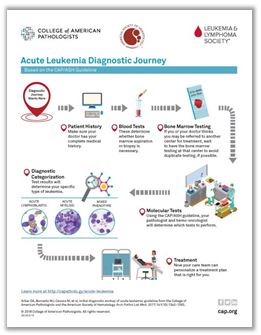Diagnosing acute lymphoblastic leukemia (ALL) and your ALL subtype usually involves a series of tests. An accurate diagnosis of the subtype is important. The exact diagnosis helps the doctor
- Estimate how the disease will progress
- Determine the appropriate treatment.
Blood and Bone Marrow Tests
Complete Blood Count (CBC) with Differential. This test is used to measure the number of red blood cells, white blood cells and platelets in a sample of blood. It measures the amount of hemoglobin in the red blood cells. The CBC should include a differential. The differential measures the numbers of the different types of white blood cells in the sample. People with acute lymphoblastic leukemia (ALL) often have a high number of white blood cells, but most of these are leukemia cells that do not protect against infection. Meanwhile, they do not have enough mature white blood cells and may also have a low number of red blood cells and platelets.
If the CBC findings suggest leukemia, a diagnosis of ALL can sometimes be confirmed with additional testing of the blood sample. Sometimes, however, an ALL diagnosis can be made only after the examination of a sample of bone marrow cells.
Bone Marrow Aspiration and Biopsy. These two procedures are generally done at the same time in a doctor's office or a hospital. For both procedures, the patient is given medication to numb the area, or given a general anesthesia. The samples are usually taken from the hip bone using specialized needles.
- A bone marrow aspiration removes a liquid marrow sample
- A bone marrow biopsy removes a small amount of bone filled with marrow
Cell Assessment. A hematopathologist will examine a sample of blood cells or bone marrow cells under the microscope to determine the size, shape, and type of cells as well as to identify other features of the cells. A significant finding is the appearance of the cells—whether the cells look more like normal, mature blood cells or more like abnormal, immature blood cells (blast cells).
Immunophenotyping (Flow Cytometry). This lab test identifies the antigens, or proteins, on the surface of cancer cells. Finding (or not finding) certain proteins can help the hematopathologist determine the type of leukemia or lymphoma. The pattern of the surface proteins is called the “immunophenotype.” A bone marrow sample is often used for this test, but it can also be done using cells from the blood, lymph nodes and other tissues. Leukemia cells can have different antigens (proteins) on their surfaces, depending on the type of leukemia. Finding, or not finding, these antigens, called “cluster of differentiation (CD) proteins,” can help the hematopathologist determine the type of leukemia. Immunophenotyping is used to determine the type of lymphocytes (B cells or T cells) and to assess the maturity of the cells. B-cell ALL and T-cell ALL each have a common pattern of proteins. This test is also used after treatment for evaluating minimal/measurable residual disease (MRD).
Genetic Tests
The following tests are used to identify, examine and measure chromosomes and genes.
Cytogenetic Analysis (Karyotyping). In this test a hematopathologist uses a microscope to examine the chromosomes inside of cells. Karyotyping is used to look for abnormal changes in the chromosomes of the leukemia cells of patients with ALL.
Cytogenetic testing is done using either a bone marrow or a blood sample. The leukemia cells in the sample are allowed to grow in the laboratory and then they are stained prior to examination. The stained sample is examined under a microscope and then photographed to show the arrangement of the chromosomes (the karyotype). The karyotype will show if there are any abnormal changes in the size, shape, structure or number of chromosomes in the leukemia cells.
Cytogenetic analysis provides information that is important when determining a patient’s treatment options and prognosis. This information can predict how the disease will respond to therapy. For example, a translocation between chromosomes 9 and 22 is associated with a diagnosis of Philadelphia chromosome-positive (Ph+) ALL, a subtype of ALL that is treated differently than other subtypes.
Fluorescence in situ Hybridization (FISH). This is a cytogenetic laboratory technique that is used to identify and examine genes or chromosomes in cells and tissues. In cases of ALL, doctors use FISH to detect certain abnormal changes in the chromosomes and genes of leukemia cells.
Polymerase Chain Reaction (PCR). A PCR is a very sensitive laboratory technique that is used to detect and measure some genetic mutations and chromosomal changes that are too small to be seen with a microscope. Polymerase chain reaction testing essentially increases or “amplifies” small amounts of specific pieces of either RNA (ribonucleic acid) or DNA to make them easier to detect and measure. This test can find a single leukemia cell among more than 500,000 to one million normal cells. Polymerase chain reaction testing is one method used to determine the amount of minimal residual disease (MRD), the small amount of cancer cells left in the body after treatment. This testing can be done on a bone marrow or a blood sample.
Diagnosing ALL
After your doctor takes samples of your blood and bone marrow, a hematopathologist confirms a diagnosis and identifies the ALL subtype. A hematopathologist is a specialist who studies blood cell diseases by looking at samples of blood and marrow cells and other tissues.
The diagnosis of ALL is confirmed by identifying:
- Leukemic blast of lymphoid origin (lymphoblasts) in the bone marrow samples
- The percentage of blast cells in the bone marrow
- Typically, there are no blast cells in the blood and no more than 5 percent of the cells in the bone marrow are blast cells. In ALL, at least 20 percent of the cells in the bone marrow are lymphoblasts.
If you're diagnosed with ALL, blood and bone marrow tests are also done during or after treatment to see how your ALL cells are responding to therapy.
Click here for the steps involved with a new diagnosis of acute leukemia.
Newly Diagnosed Checklist
The College of American Pathologists (CAP) and the American Society of Hematology (ASH) provide practical guidance for patients and caregivers coping with a new diagnosis of acute leukemia. This checklist will help ensure that you receive the best treatment for your unique situation: Click Here
Related Links
- Download or order The Leukemia & Lymphoma Society's free booklet, Acute Lymphoblastic Leukemia.
- Blood Tests
- Understanding Blood Counts
- Bone Marrow Tests
- Questions and Answers for Patients With Acute Leukemia

